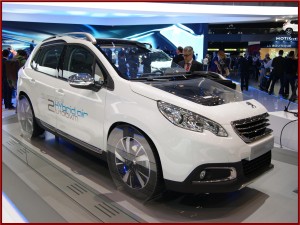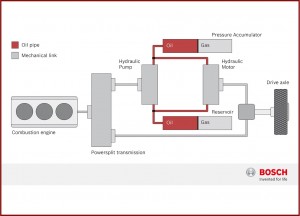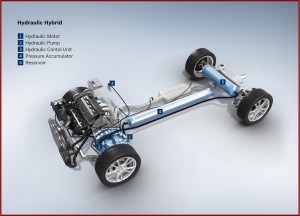
The engine combines with hydraulic units and a nitrogen pressure accumulator to provide a brief boost on launch or during vehicle acceleration.
Struggling PSA Peugeot Citroën showed a light duty version of what it calls hybrid air technology, but is really a version of hydraulic boost. PSA claims that the system will be in production by 2016 using the group’s new EMP2 platform that debuts with a revised Citroen Picasso.This is potentially a breakthrough that will help PSA sell more cars globally, reviving its sagging reputation in the process. Similar hydraulic boost technology is already in use on much larger trucks, buses and delivery vans. (For an amusing and literate discussion on this badly named system, be sure to read Hydraulic Hybrid at Simanaitis Says)
Developed along with Bosch to show another direction engine technology can take, the 208 Hybrid FE concept made its world debut in Geneva against a backdrop of new and ultra expensive sports cars for the wealthy, including a Ferrari hybrid. The difference is PSA wants to sell its hybrid at about $24,000, a price reduction from most hybrids, plug-in hybrids or pure EVs because hybrid air technology does not use expensive lithium ion batteries.

Hydraulic units compress a gas cushion with fluid and gas kept separate from one another. The gas stores energy by being compressed somewhat like a coil spring. When pressure within the accumulator is relieved, the system works in reverse – the gas expands once more, providing a compressive force on the hydraulic fluid driving a hydraulic motor that delivers power via the transmission. The amount of energy that can be stored depends on the size of the system.
Instead, PSA combines what it claims are tried and tested systems from its new generation of three-cylinder gasoline engines with compressed air technology. More than 80 patents have been issued thus far. The conventional internal-combustion engine combines with hydraulic units and an accompanying nitrogen pressure accumulator to provide a brief boost to acceleration.
The hybrid system is able to support gasoline and diesel engines in ranges where they do not work at optimum efficiency. As is typical with other types of hybrids, the hybrid air system makes use of braking energy converting kinetic energy captured into hydraulic energy and stored in the pressure accumulator.
This hybrid technology is about combining two forms of energy to achieve the highest efficiency in various situations. The compressed air system will assist, or even take the place of, the gas engine during the phases, which consume the most energy – acceleration and lunching from a stop. Sub systems include the gasoline engine, a compressed air energy storage unit, a hydraulic pump/motor unit and an automatic transmission with an epicyclic geartrain.
A computer manages input from the driver to optimize energy efficiency with three operating modes:
- Air power, with zero emissions. But available energy from Hybrid Air is only 0.04 kWh.
- Gasoline power, using just the 1.2-liter engine
- Combined power, with the combustion engine and hydraulic motor working together
“Although the idea of using compressed air to power cars dates from the late 1950s, the challenge is to prepare components that haven’t previously been used in mass production in the car industry, said Dr Karim Mokaddem, hybrid-air project director.
Work on the project started two years ago and first prototypes were efficient in city driving but less efficient at higher speeds. The company is now onto its fourth generation and is promising a 45% fuel reduction over the equivalent gasoline engine and CO2 emissions down to 69g/km.
 “The other bonus is that the technology is more affordable at “about half the cost of traditional hybrids,” Mokaddem said.
“The other bonus is that the technology is more affordable at “about half the cost of traditional hybrids,” Mokaddem said.
The prototype shown also has new Michelin tires with specific sizing (165/50 R18) that are said to cut fuel consumption by almost 0.2l/100km and are designed with a particularly large diameter and a reduced width for lower rolling resistance, weight and noise.
The technology could also help GM stockholders. Last year GM wrote down more than $5 billion in assets in the Eurozone, and wrote off more than half the value the PSA Citroen stock (-$220 million) it acquired latest year in what it said was a collaboration that would, eventually, save billions.
Read AutoInformed on:
- EU Car Registrations Plummet in January as Eurozone Crisis Deepens
- EU Commercial Vehicle Sales Drop 11% in January as Slump Continues
- Chevrolet Debuts 2014 Corvette Stingray Convertible
- LaFerrari, a 900 Horsepower V12 Hybrid Unveiled at Geneva
- French Government Backs €7 Billion in PSA Peugeot Citroën Debt
- GM and PSA Peugeot Citroën to Develop New Gas Engines
- GM Earns $4.9 Billion in 2012 down from $7.6 Billion in 2011


